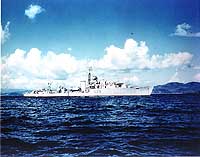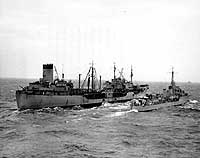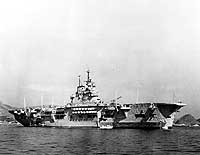
During the first weeks of UN involvement in the Korean War, one of the two aircraft carriers on the scene was the British light fleet carrier Triumph. She remained in action during much of the conflict's first three months, and was relieved by a sister ship, HMS Theseus, in September 1950. Other RN and RAN light fleet carriers taking part in combat operations were HMS Glory, HMS Ocean and HMAS Sydney. These five very similar ships, of a size and speed between the U.S. Navy's escort carriers and Essex class fleet carriers, generally operated along Korea's west side. They deployed a variety of piston-engined aircraft, including "Seafire", "Firefly" and "Sea Fury" types. In 1952, one of the latter achieved the remarkable feat of shooting down a high-performance MiG-15 jet fighter.
The British and the Commonwealth nations also contributed six-inch and lighter gunfire to the support of forces on land, and to patrol and blockading functions offshore. Among the Royal Navy cruisers serving off Korea at different times were H.M. Ships Belfast, Birmingham, Newcastle, Ceylon, Jamaica and Kenya. British, Australian, New Zealand and Canadian destroyers and frigates were vigorously and effectively employed. In July-September 1950, HMS Black Swan (frigate), HMS Comus (destroyer) and cruiser Jamaica were hit by enemy air strikes, among the few such attacks made on ships during the entire conflict.
A notable British navy vessel that was present for nearly the entire war, though generally stationed in port in Japan, was the aircraft maintenance ship Unicorn. Though she looked like an aircraft carrier, and could act as one if the situation required, she was really a floating aircraft rework facility. Rarely enough for an auxiliary, and even more rarely for a carrier, in 1953 she actually used her four-inch guns to bombard targets in North Korea.
This page provides images of Korean War British and British Commonwealth naval vessels.
Other views on British and Commonwealth involvement in the Korean War will be found under: -- British and Commonwealth Forces.
For pictorial coverage of the Korean War activities of other
United Nations members, and of the Republic of Korea, see:
For a precis of our Korean War images, and links to more
comprehensive pictorial coverage of that conflict, see:
| If you want higher resolution reproductions than the Online Library's digital images, see: How to Obtain Photographic Reproductions. |
Click on the small photograph to prompt a larger view of the same image.
|
Photo #: NH 99085 HMS Belfast (British Light Cruiser, 1939) In the channel at Pusan, Korea, 2 April 1952. USS Consolation (AH-15) is also present, beyond Belfast's bow. Official U.S. Navy Photograph, from the collections of the Naval Historical Center. Online Image: 103KB; 740 x 610 pixels |
 |
|
Photo #: 80-G-633883 HMS Belfast (British Light Cruiser, 1939) Coming alongside USS Bataan (CVL-29) while operating off the coast of Korea on 27 May 1952. One of Bataan's 40mm twin gun mounts is in the left foreground. Official U.S. Navy Photograph, now in the collections of the National Archives. Online Image: 97KB; 740 x 610 pixels Reproductions of this image may also be available through the National Archives photographic reproduction system. |
 |
|
Photo #: NH 90625 British Commonwealth Destroyers Moored off Yokosuka, Japan, after returning from combat patrols in Korean Waters. Photo is dated 26 January 1951. The ships are (from left to right): HMAS Warramunga (Australian Destroyer, 1942); HMAS Charity (British Destroyer, 1945) and HMAS Bataan (Australian Destroyer, 1945). Official U.S. Navy Photograph, from the collections of the Naval Historical Center. Online Image: 97KB; 740 x 620 pixels |
 |
|
Photo #: NH 97046 Destroyers of British Commonwealth Navies Tied to a mooring bouy at a southern Japanese port (presumably Sasebo), after "an extended period of operations in Korean waters", circa May 1951. The ships are (from left): HMAS Warramunga (Australian Destroyer, 1942); HMCS Nootka (Canadian Destroyer, 1946) and HMS Cockade (British Destroyer, 1945). All three are assigned to the United Nations Blockading and Escort Force, commanded Rear Admiral Allan E. Smith, USN. This photograph was released by Commander, Naval Forces Far East on 19 May 1951. Official U.S. Navy Photograph, from the "All Hands" collection at the Naval Historical Center. Online Image: 156KB; 740 x 615 pixels |
 |
|
Photo #: 80-G-K-14206 (Color) HMS Charity (British Destroyer, 1945) Off the Korean coast, while covering Operation "Fishnet", which was intended to destroy North Korean fishing nets in an effort to reduce Communist forces' food supplies. Photograph is dated 16 September 1952. Official U.S. Navy Photograph, now in the collections of the National Archives. Online Image: 110KB; 740 x 605 pixels Reproductions of this image may also be available through the National Archives photographic reproduction system. |
 |
|
Photo #: NH 96261 USS Manatee (AO-58) Refueling HMAS Warramunga (Australian destroyer, 1942) in Korean waters. Photograph is dated 27 June 1951. Official U.S. Navy Photograph, from the collections of the Naval Historical Center. Online Image: 81KB; 740 x 610 pixels |
 |
|
Photo #: 80-G-427411 HMS Unicorn (British Aircraft Maintenance Carrier, 1943) Moored in a southern Japanese port (probably Sasebo) after a tour of duty in Korean waters. Photo is dated 15 March 1951. Official U.S. Navy Photograph, now in the collections of the National Archives. Online Image: 83KB; 740 x 600 pixels Reproductions of this image may also be available through the National Archives photographic reproduction system. |
 |
Other views on British and Commonwealth involvement in the Korean War will be found under: -- British and Commonwealth Forces.
For pictorial coverage of the Korean War activities of other
United Nations members, and of the Republic of Korea, see:
For a precis of our Korean War images, and links to more
comprehensive pictorial coverage of that conflict, see:
| If you want higher resolution reproductions than the Online Library's digital images, see: How to Obtain Photographic Reproductions. |
Page made 4 September 2000
New image added 17 January 2004